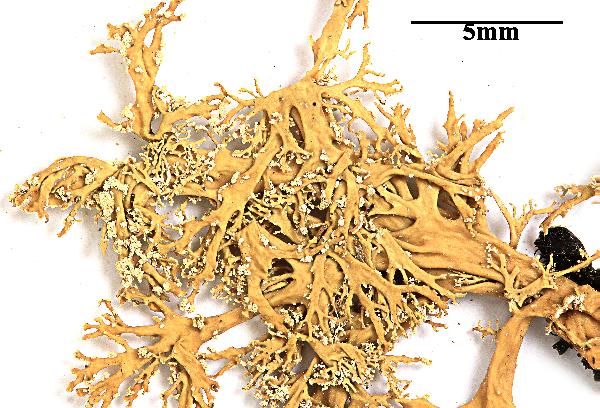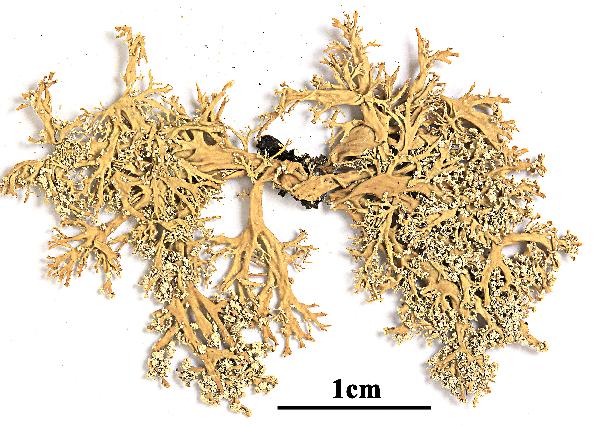Ramalina roesleri (Schaer.) Nyl.
Bull. Soc. linn. Normandie, sér. 2, 4: 165 (note), 1870. Basionym: Ramalina farinacea var. roesleri Höchst. ex Schaer. - Enum. Crit. Lich. Eur.: 9, 1850.
Synonyms: Fistulariella roesleri (Schaer.) Bowler & Rundel; Ramalina pollinariella (Nyl.) Nyl.
Distribution: N - Ven, TAA (Dalla Torre & Sarnthein 1902, Nascimbene & al. 2007b). C - Tosc (Brackel 2015), Sar (Tretiach 1993). S - Si (Tretiach 1993, Nimis & al. 1994, Ottonello & Salone 1994, Ottonello & Romano 1997, Ravera & al. 2023b).
Description: Thallus fruticose, pale green, 1-6 cm long, loosely tufted, erect to subpendulous, the primary branches flattened, 1-2.5 mm broad, richly branched, the secondary branches mostly arranged at right angles to the main axis, often repeatedly branched, ending in many fine, terete, often apically hooked branchlets. Surface smooth, glossy, sparingly to abundantly fenestrate. Medulla subfistulose, arachnoid to hollow in the inflated parts. Soralia punctiform, terminal or subterminal, consisting of a few granular soredia. Apothecia very rare, lecanorine, terminal or subterminal, with an often pruinose disc. Epithecium pale olive; hymenium and hypothecium colourless; paraphyses thick-walled, richly branched in upper part. Asci 8-spored, clavate to cylindrical-clavate, the apical dome K/I+ dark blue with a pale, conical-pointed apical cushion (axial mass) never penetrating through the entire d-layer, the wall K/I-, but the thin outer gel K/I+ blue, Bacidia-type. Ascospores 1-septate, hyaline, straight, 11-16 x 5-6.5 µm. Photobiont chlorococcoid. Spot tests: K-, C-, KC- or KC+ pale yellow (cortex only), P-. UV-. Chemistry: cortex with usnic acid; medulla with substances of the sekikaic acid complex.Note: both in open humid beech forests and in very humid Mediterranean maquis vegetation, perhaps extinct in Northern Italy. Very abundant on shrubs on the island of Marettimo, at c. 300-400 m, in a belt dominated by Teloschistes chrysophthalmos with variable air humidity conditions (frequent alternance between fog and sun). It is included in the Italian red list of epiphytic lichens as “Vulnerable” (Nascimbene & al. 2013c).
Growth form: Fruticose
Substrata: bark
Photobiont: green algae other than Trentepohlia
Reproductive strategy: mainly asexual, by soredia, or soredia-like structures (e.g. blastidia)
Most common in areas with a humid-warm climate (e.g. most of Tyrrenian Italy)
Commonnes-rarity: (info)
Alpine belt: absent
Subalpine belt: absent
Oromediterranean belt: absent
Montane belt: extremely rare
Submediterranean belt: absent
Padanian area: absent
Humid submediterranean belt: extremely rare
Humid mediterranean belt: extremely rare
Dry mediterranean belt: absent
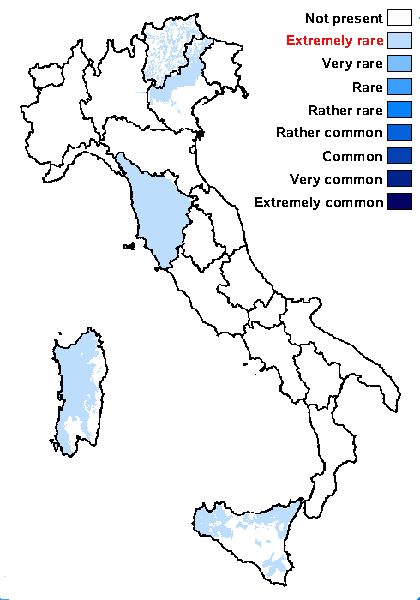
Predictive model
Herbarium samples
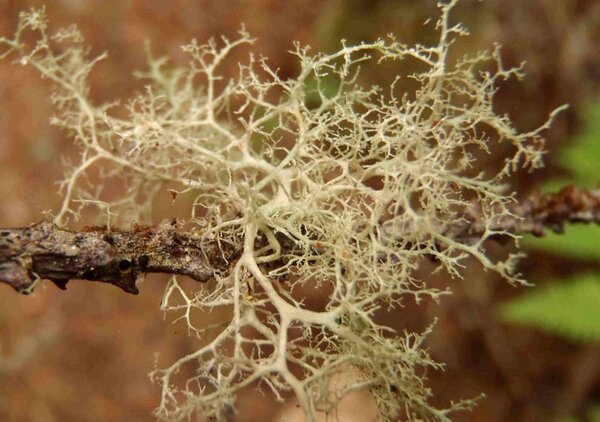

Curtis Randall Björk – CC BY-SA 4.0
California, Humboldt County, Samoa Dunes Date: 2011-07-08 On Picea twig in backdune forest, near marine shoreline
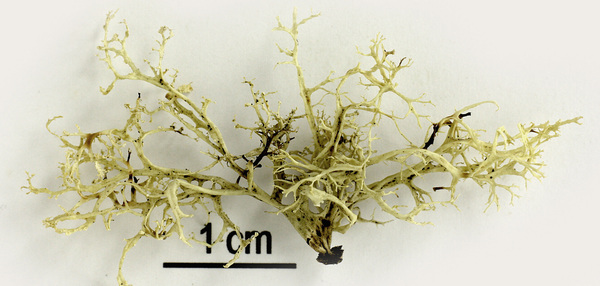
Felix Schumm - CC BY-SA 4.0
[11092], Österreich: East Tyrol, southern foothills of the Hochvenediger Mountains, Virgental District, humid conifer stand around the cascade of the Großbach before joining the Iseltal, on marginal twigs of Picea abies, associated with Ramalina thrausta, 1550 m. Leg et det. Follmann 08.1978. G. FOLLMANN: NR. 464 LICH. EXSICC. SEL
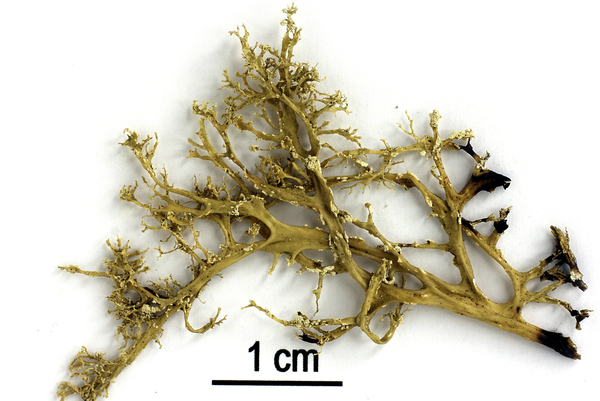
Felix Schumm - CC BY-SA 4.0
[12151], Türkei, Prov. Trabzon (61), Zigana Daglari, Solma Yaylasi, southwest of Macka. In a depression in forest stand. 40°51' N, 39°33' E, 1700 m, on twigs of Alnus glutinosa. Leg et det. V. John 03.07.2004. EX HERBARIO VOLKER JOHN NR. 11260
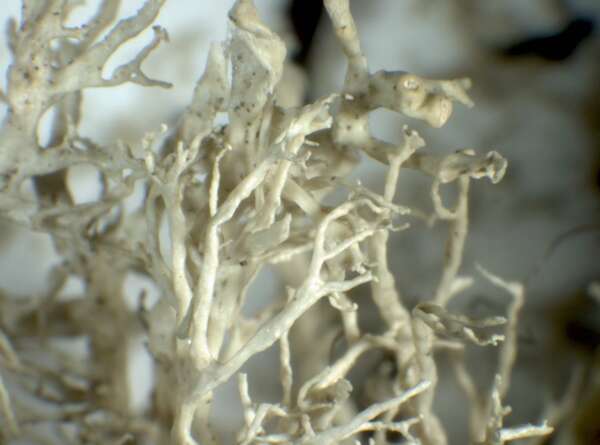

P.L. Nimis; Owner: Department of Life Sciences, University of Trieste
Herbarium: TSB (15703)
2001/12/07
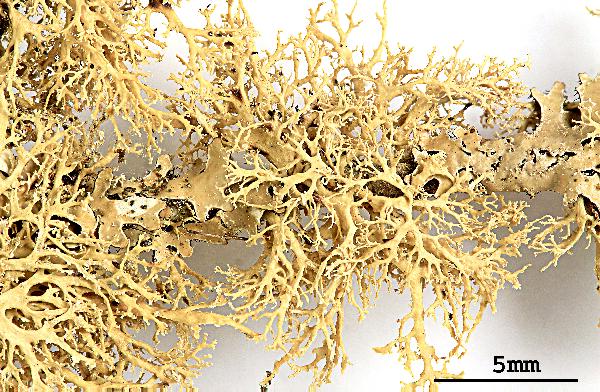

Felix Schumm - CC BY 4.0
[OH546], Japan.Hokkaido. Prov. Kushiro: Wakoto Peninsula, Kawakami-
gun (43°35' N, 144°19' E). On bark of Abies sachalinensis, 100 m.
Leg. H. Kashiwadani (no. 45771), 24.07.2003, det. H. Kashiwadani. EX
Y. OHNMURA: LICHENES MINUS COGNITI EXSICCATI NO. 546.


Felix Schumm - CC BY 4.0
[OH546], Japan.Hokkaido. Prov. Kushiro: Wakoto Peninsula, Kawakami-
gun (43°35' N, 144°19' E). On bark of Abies sachalinensis, 100 m.
Leg. H. Kashiwadani (no. 45771), 24.07.2003, det. H. Kashiwadani. EX
Y. OHNMURA: LICHENES MINUS COGNITI EXSICCATI NO. 546.
Growth form: Fruticose
Substrata: bark
Photobiont: green algae other than Trentepohlia
Reproductive strategy: mainly asexual, by soredia, or soredia-like structures (e.g. blastidia)
Most common in areas with a humid-warm climate (e.g. most of Tyrrenian Italy)
Commonnes-rarity: (info)
Alpine belt: absent
Subalpine belt: absent
Oromediterranean belt: absent
Montane belt: extremely rare
Submediterranean belt: absent
Padanian area: absent
Humid submediterranean belt: extremely rare
Humid mediterranean belt: extremely rare
Dry mediterranean belt: absent

Predictive model
| Herbarium samples |


Curtis Randall Björk – CC BY-SA 4.0
California, Humboldt County, Samoa Dunes Date: 2011-07-08 On Picea twig in backdune forest, near marine shoreline

Felix Schumm - CC BY-SA 4.0
[11092], Österreich: East Tyrol, southern foothills of the Hochvenediger Mountains, Virgental District, humid conifer stand around the cascade of the Großbach before joining the Iseltal, on marginal twigs of Picea abies, associated with Ramalina thrausta, 1550 m. Leg et det. Follmann 08.1978. G. FOLLMANN: NR. 464 LICH. EXSICC. SEL

Felix Schumm - CC BY-SA 4.0
[12151], Türkei, Prov. Trabzon (61), Zigana Daglari, Solma Yaylasi, southwest of Macka. In a depression in forest stand. 40°51' N, 39°33' E, 1700 m, on twigs of Alnus glutinosa. Leg et det. V. John 03.07.2004. EX HERBARIO VOLKER JOHN NR. 11260


P.L. Nimis; Owner: Department of Life Sciences, University of Trieste
Herbarium: TSB (15703)
2001/12/07


Felix Schumm - CC BY 4.0
[OH546], Japan.Hokkaido. Prov. Kushiro: Wakoto Peninsula, Kawakami- gun (43°35' N, 144°19' E). On bark of Abies sachalinensis, 100 m. Leg. H. Kashiwadani (no. 45771), 24.07.2003, det. H. Kashiwadani. EX Y. OHNMURA: LICHENES MINUS COGNITI EXSICCATI NO. 546.


 Index Fungorum
Index Fungorum
 GBIF
GBIF

